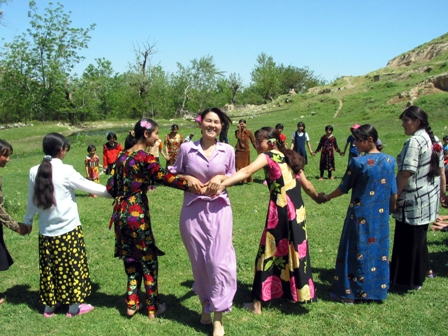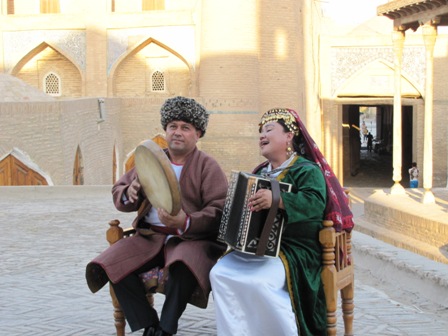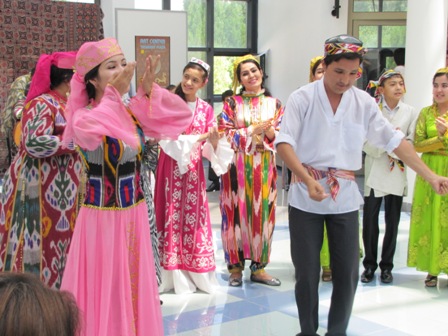Dutar and Surnay Maqom Cycles

Domain: Performing Arts
Index Number: 02.01.04
Dutar (in Farsi - "two strings") is a stringed musical instrument, which is widely-spread in the culture of peoples of Central Asia (Uzbeks, Uigurs, Tajiks, Turkmens and Karakalpaks). Uzbek dutar differs from other musical instruments with its soft, beautiful and expressive sound.
It has two silk strings, which are weakly stringed. Its scale is up to two octaves. In Uzbekistan it is possible to observe dutars of different shape (form) and length (such as Ferghana dutar, Kashgar dutar, Khoresm dutar, Bukhara dutar, Boysun dutar, etc.). Dutar is usually tuned to the fourth (Tanovar), fifth (Munojot) and to unison (qoshtor). It bears mentioning that this musical instrument occupies a leading place in traditional performance (especially among women). In the ХХ century several schools of performance existed in Uzbekistan (i.e. in Andijan, Tashkent, Ferghana, Samarkand and Khoresm), in which learning was based on "ustoz-shogird" ("master-apprentice") methodology. Though, each of them differed from the rest with its specific character, style as well as bearers of traditions. From among popularizers of dutar playing art it is possible to mention М. Najmiddinov, O. Rustamov, K. Madraimov, A. Bakhobov, F. Sodiqov, М. Yunusov, Т. Alimatov, Z. Obidov, О. Qosimov, А. Abdurasulov, S. Yusupov, N. Boltaev, M. Sheroziy, N. Qulabdullaev, А.Khamidov, M. Ziyoyeva and others. In the most cases folk and oral-professional instrumental melodies and pieces (in particular, instrumental and vocal pieces of Shashmaqom, Ferghana-Tashkent maqoms, instrumental maqom cycles and pieces) are played on dutar.
In the ХIХ-ХХ centuries dutar maqom cycles became widespread in Khoresm. And by using so called "Khoresm tanbur notation" six dutar maqoms (i.e. Zikhi Nazzora-Urganji, Miskin, Rakhoviy, Iroqi, Ohyor, Choki Giribon) together with their cyclic parts were written. In accordance with written sources (especially based on the information provided by "Short History of Khoresm Music"), 11 maqom cycles (Iroq, Chapandoz, Mogulcha, Navoiy, Sadri Iroq, Roviy, Orazi bom, Tashniz, Majnun Dali, Okhyor, Miskin; each consists of 2-7 parts) for dutar have so far been preserved and are used in practice. For instance, the cycle of Zikhi Nazzora-Urganji consists of Zikhi Nazzora, Talqini Zikhi Nazzora, Tarjibandi Zikhi Nazzora, Qaddim khamliki, Talqini Urganji, Naqshi Talqini Urganji, Iyfori Talqini Urganji (7 parts); or maqom Miskin consists of Miskin, Talqini Miskin, Naqshi Miskin, Iyfori Miskin (Iyfori here means ufar). Nowadays, dutar maqom cycles and pieces enjoy popularity, and are included in the repertoires of famous performers. They are also studied at secondary special and higher educational institutions.

In Uzbekistan two styles of performance on surnay are widespread, i.e. Ferghana-Tashkent style (in which mensuration is broader, the sound is beautiful and somewhat ornamental) and Khoresm style (in which mensuration is less thick while the sound is soft and resonant). Besides surnay, it is possible to observe in Khoresm another musical instrument called bolaman, a surnay-like instrument of smaller size, which produces soft, dull sound. Also, in Surkhandarya one can find a variation of surnay called metar. In Khoresm, major sound-making methods are called "qaytarma nafas" ("returning breath") and "dam aylantirish" ("rotating breath").
The repertoire includes folk and oral-professional melodies and cycles. Though, maqom pieces and cycles enjoy special popularity. "Khon chiqar" ("Appearance of Khan") melody, the one which is popular in Khoresm, and which is performed by the ensemble of surnay players (musical instruments used include surnay and bolaman), is based on the melody of Sakil from maqom of "Navo".
Maqom pieces and cycles for surnay (so called "surnay maqom yollari" ("surnay maqom cycles")) such as Buzruk, Navo, Dugoh, Segoh, Iroq, Uzzol, Dugoh-Husayni, Mustahzod, Chorgoh, Yakkakhonlik, etc., which are performed in family- and community-related festivities and celebrations are popular in Ferghana Valley. There are also independent pieces, such as "Surnai navosi" or "Surnai dugohi" as well as cycles as "Buzruk – Buzruk savti", "Navo – Navo savti – Navo charhi 1-2", "Dugoh – Dugoh Husayni – Dugoh ufari", "Surnay Uzzoli – Uzzol savti – Uzzol Ufari", "Iroq – Iroq Ufari – Iroq duchavasi – Choli Iroq", etc. Their melodies, usuls and structures are almost identical with those of Shashmaqom, though they differ in terms of performance traditions and styles, which are peculiar for Ferghana Valley. Popularizers of surnay and surnay maqom pieces were famous musicians like Rustam mehtar ("mehtar" in the past meant "a head of a guild of musicians"), Ashurali mehtar, Khamroqul bolaman, Akhmadjon Umurzoqov, Khudoybergan Qurbon oghli, Abduqayum ota Azimov, Qodirboy Bobojonov, Ashurali Yusupov. At present these are Yoldosh Tojiev, Akhmadjon Khojiboev, Matrasul Matyaqubov and others.
Nowadays the traditions of playing on surnay are mastered through "ustoz-shogird" (master-apprentice) methodology and through the official system of music education at music and art colleges, conservatoires, etc. (Notably, a performer of surnay, whily studying at these educational institutions, simultaneously masters the skill of playing on bolaman and qoshnay). To this date relevant educational programmes and textbooks have been developed, which are currently used in music education. In addition, competitions of traditional performance on surnay are organized on a regular basis.














